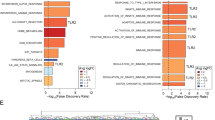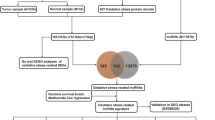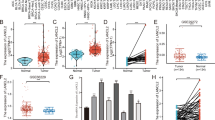Abstract
Toll-like receptors (TLRs) are key regulators of innate immune responses, and their dysregulation is observed in numerous inflammation-associated malignancies, including gastric cancer (GC). However, the identity of specific TLRs and their molecular targets which promote the pathogenesis of human GC is ill-defined. Here, we sought to determine the clinical utility of TLR2 in human GC. TLR2 mRNA and protein expression levels were elevated in >50% of GC patient tumors across multiple ethnicities. TLR2 was also widely expressed among human GC cell lines, and DNA microarray-based expression profiling demonstrated that the TLR2-induced growth responsiveness of human GC cells corresponded with the up-regulation of six anti-apoptotic (BCL2A1, BCL2, BIRC3, CFLAR, IER3, TNFAIP3) and down-regulation of two tumor suppressor (PDCD4, TP53INP1) genes. The TLR2-mediated regulation of these anti-apoptotic and tumor suppressor genes was also supported by their increased and reduced expression, respectively, in two independent genetic GC mouse models (gp130F/F and Gan) characterized by high tumor TLR2 expression. Notably, enrichment of this TLR2-regulated gene signature also positively correlated with augmented TLR2 expression in human GC tumors, and served as an indicator of poor patient survival. Furthermore, treatment of gp130F/F and cell line-derived xenograft (MKN1) GC mouse models with a humanized anti-TLR2 antibody suppressed gastric tumor growth, which was coincident with alterations to the TLR2-driven gene signature. Collectively, our study demonstrates that in the majority of GC patients, elevated TLR2 expression is associated with a growth-potentiating gene signature which predicts poor patient outcomes, thus supporting TLR2 as a promising therapeutic target in GC.
This is a preview of subscription content, access via your institution
Access options
Subscribe to this journal
Receive 50 print issues and online access
$259.00 per year
only $5.18 per issue
Buy this article
- Purchase on SpringerLink
- Instant access to full article PDF
Prices may be subject to local taxes which are calculated during checkout







Similar content being viewed by others
References
Crew K, Neugut AI . Epidemiology of gastric cancer. World J Gastroenterol 2006; 12: 354–362.
Correa P, Piazuelo MB . Helicobacter pylori Infection and Gastric Adenocarcinoma. US Gastroenterol Hepatol Rev 2011; 7: 59–64.
Cunningham D, Allum WH, Stenning SP, Thompson JN, Van de Velde CJ, Nicolson M et al. Perioperative chemotherapy versus surgery alone for resectable gastroesophageal cancer. N Engl J Med 2006; 355: 11–20.
Ooi C, Ivanova T, Wu J, Lee M, Tan IB, Tao J et al. Oncogenic pathway combinations predict clinical prognosis in gastric cancer. PLoS Genet 2009; 5: e1000676.
Cancer Genome Atlas Research Network. Comprehensive molecular characterization of gastric adenocarcinoma. Nature 2014; 513: 202–209.
Lordick F, Allum W, Carneiro F, Mitry E, Tabernero J, Tan P et al. Unmet needs and challenges in gastric cancer: the way forward. Cancer Treat Rev 2014; 40: 692–700.
Fox J, Wang TC . Inflammation, atrophy, and gastric cancer. J Clin Invest 2007; 117: 60–69.
Parkin D . The global health burden of infection-associated cancers in the year 2002. Int J Cancer 2006; 118: 3030–3044.
Kawai T, Akira S . The role of pattern-recognition receptors in innate immunity: update on Toll-like receptors. Nat Immunol 2010; 11: 373–384.
Mandell L, Moran AP, Cocchiarella A, Houghton J, Taylor N, Fox JG et al. Intact gram-negative Helicobacter pylori, Helicobacter felis, and Helicobacter hepaticus bacteria activate innate immunity via toll-like receptor 2 but not toll-like receptor 4. Infect Immun 2004; 72: 6446–6454.
Savva A, Roger T . Targeting toll-like receptors: promising therapeutic strategies for the management of sepsis-associated pathology and infectious diseases. Front Immunol 2013; 4: 387.
Tahara T, Arisawa T, Wang F, Shibata T, Nakamura M, Sakata M et al. Toll-like receptor 2 -196 to 174del polymorphism influences the susceptibility of Japanese people to gastric cancer. Cancer Sci 2007; 98: 1790–1794.
Zeng HM, Pan KF, Zhang Y, Zhang L, Ma JL, Zhou T et al. Genetic variants of toll-like receptor 2 and 5, helicobacter pylori infection, and risk of gastric cancer and its precursors in a chinese population. Cancer Epidemiol Biomarkers Prev 2011; 20: 2594–2602.
Uno K, Kato K, Atsumi T, Suzuki T, Yoshitake J, Morita H et al. Toll-like receptor (TLR) 2 induced through TLR4 signaling initiated by Helicobacter pylori cooperatively amplifies iNOS induction in gastric epithelial cells. Am J Physiol Gastrointest Liver Physiol 2007; 293: 1004–1012.
Tye H, Kennedy C, Najdovska M, McLeod L, McCormack W, Hughes N et al. STAT3-driven upregulation of TLR2 promotes gastric tumorigenesis independent of tumor inflammation. Cancer Cell 2012; 22: 466–478.
Kennedy CL, Najdovska M, Tye H, McLeod L, Yu L, Jarnicki A et al. Differential role of MyD88 and Mal/TIRAP in TLR2-mediated gastric tumourigenesis. Oncogene 2013; 33: 2540–2546.
Wu Y, Grabsch H, Ivanova T, Tan IB, Murray J, Ooi CH et al. Comprehensive genomic meta-analysis identifies intra-tumoural stroma as a predictor of survival in patients with gastric cancer. Gut 2013; 62: 1100–1111.
Itadani H, Oshima H, Oshima M, Kotani H . Mouse gastric tumor models with prostaglandin E2 pathway activation show similar gene expression profiles to intestinal-type human gastric cancer. BMC Genomics 2009; 10: 615–622.
Meng G, Rutz M, Schiemann M, Metzger J, Grabiec A, Schwandner R et al. Antagonistic antibody prevents toll-like receptor 2-driven lethal shock-like syndromes. J Clin Invest 2004; 113: 1473–1481.
Reilly M, Miller RM, Thomson MH, Patris V, Ryle P, McLoughlin L et al. Randomized, double-blind, placebo-controlled, dose-escalating phase I, healthy subjects study of intravenous OPN-305, a humanized anti-TLR2 antibody. Clin Pharmacol Ther 2013; 94: 593–600.
Castaño-Rodríguez N, Kaakoush NO, Goh KL, Fock KM, Mitchell HM . The role of TLR2, TLR4 and CD14 genetic polymorphisms in gastric carcinogenesis: a case-control study and meta-analysis. PLoS One 2013; 8: e60327.
Pimentel-Nunes P, Alfonso L, Lopes P, Roncon-Albuquerque R Jr, Gonçalves N, Henrique R et al. Increased expression of toll-like receptors (TLR) 2, 4 and 5 in gastric dysplasia. Pathol Oncol Res 2011; 17: 677–683.
Pimentel-Nunes P, Goncalves N, Boal-Carvalho I, Afonso L, Lopes P, Roncon-Albuquerque R Jr et al. Helicobacter pylori induces increased expression of Toll-like receptors and decreased Toll-interacting protein in gastric mucosa that persists throughout gastric carcinogenesis. Helicobacter 2013; 18: 22–32.
de Oliveira JG, Silva AE . Polymorphisms of the TLR2 and TLR4 genes are associated with risk of gastric cancer in a Brazilian population. World J Gastroenterol 2012; 18: 1235–1242.
Je EM, Kim SS, Yoo NJ, Lee SH . Mutational and expressional analyses of MYD88 gene in common solid cancers. Tumori 2012; 98: 663–669.
Maeda Y, Echizen K, Oshima H, Yu L, Sakulsak N, Hirose O et al. Myeloid differentiation factor 88 signaling in bone marrow-derived cells promotes gastric tumorigenesis by generation of inflammatory microenvironment. Cancer Prev Res 2016; 9: 253–263.
Shi W, Su L, Li Q, Sun L, Lv J, Li J et al. Suppression of toll-like receptor 2 expression inhibits the bioactivity of human hepatocellular carcinoma. Tumour Biol 2014; 35: 9627–9637.
Conti L, Lanzardo S, Arigoni M, Antonazzo R, Radaelli E, Cantarella D et al. The noninflammatory role of high mobility group box 1/Toll-like receptor 2 axis in the self-renewal of mammary cancer stem cells. FASEB J 2013; 27: 4731–4744.
Yang H, Cui B, Liu HZ, Mi S, Yan J, Yan HM et al. Blocking TLR2 activity attenuates pulmonary metastases of tumor. PLoS One 2009; 4: e6520.
Seya T, Shime H, Takeda Y, Tatematsu M, Takashima K, Matsumoto M . Adjuvant for vaccine immunotherapy of cancer–focusing on Toll-like receptor 2 and 3 agonists for safely enhancing antitumor immunity. Cancer Sci 2015; 106: 1659–1668.
Asprodites N, Zheng L, Geng D, Velasco-Gonzalez C, Sanchez-Perez L, Davila E . Engagement of Toll-like receptor-2 on cytotoxic T-lymphocytes occurs in vivo and augments antitumor activity. FASEB J 2008; 22: 3628–3637.
Kim S, Takahashi H, Lin WW, Descargues P, Grivennikov S, Kim Y et al. Carcinoma-produced factors activate myeloid cells through TLR2 to stimulate metastasis. Nature 2009; 457: 102–106.
Yang H, Wang B, Yan J, Wang T, Zhou XN, Wen HY et al. Toll-like receptor 2 promotes invasion by SGC-7901 human gastric carcinoma cells and is associated with gastric carcinoma metastasis. Ann Clin Lab Sci 2014; 44: 158–166.
Niccolai E, Taddei A, Prisco D, Amedei A . Gastric cancer and the epoch of immunotherapy approaches. World J Gastroenterol 2015; 21: 5778–5793.
Zhou XD, Yu JP, Liu J, Luo HS, Chen HX, Yu HG . Overexpression of cellular FLICE-inhibitory protein (FLIP) in gastric adenocarcinoma. Clin Sci 2004; 106: 397–405.
Li Z, Chen J, Chan KW, Qiao L, Wong BC . A possible role of cIAP2 in Helicobacter pylori-associated gastric cancer. Cancer Lett 2011; 313: 192–200.
Choi HJ, Lee JM, Kim H, Nam HJ, Shin HJ, Kim D et al. Bcl3-dependent stabilization of CtBP1 is crucial for the inhibition of apoptosis and tumor progression in breast cancer. Biochem Biophys Res Commun 2010; 400: 396–402.
Wu M . Roles of the stress-induced gene IEX-1 in regulation of cell death and oncogenesis. Apoptosis 2003; 8: 11–18.
Chen S, Xing H, Li S, Yu J, Li H, Liu S et al. Up-regulated A20 promotes proliferation, regulates cell cycle progression and induces chemotherapy resistance of acute lymphoblastic leukemia cells. Leuk Res 2015; 39: 976–983.
Piva R, Pellegrino E, Mattioli M, Agnelli L, Lombardi L, Boccalatte F et al. Functional validation of the anaplastic lymphoma kinase signature identifies CEBPB and BCL2A1 as critical target genes. J Clin Invest 2006; 116: 3171–3182.
Jiang PH, Motoo Y, Garcia S, Iovanna JL, Pébusque MJ, Sawabu N . Down-expression of tumor protein p53-induced nuclear protein 1 in human gastric cancer. World J Gastroenterol 2006; 12: 691–696.
Ma G, Zhang H, Dong M, Zheng X, Ozaki I, Matsuhashi S, Guo K . Downregulation of programmed cell death 4 (PDCD4) in tumorigenesis and progression of human digestive tract cancers. Tumour Biol 2013; 34: 3879–3885.
Zhen Y, Liu Z, Yang H, Yu X, Wu Q, Hua S et al. Tumor suppressor PDCD4 modulates miR-184-mediated direct suppression of C-MYC and BCL2 blocking cell growth and survival in nasopharyngeal carcinoma. Cell Death Dis 2013; 4: e872.
Wei Q, Li YX, Liu M, Li X, Tang H . MiR-17-5p targets TP53INP1 and regulates cell proliferation and apoptosis of cervical cancer cells. IUBMB Life 2012; 64: 697–704.
Nihon-Yanagi Y, Terai K, Murano T, Matsumoto T, Okazumi S . Tissue expression of Toll-like receptors 2 and 4 in sporadic human colorectal cancer. Cancer Immunol Immunother 2012; 61: 71–77.
Dixon M, Genta RM, Yardley JH, Correa P . Classification and grading of gastritis. The updated Sydney System. International Workshop on the Histopathology of Gastritis, Houston 1994. Am J Surg Pathol 1996; 20: 1161–1181.
Kennedy CL, Najdovska M, Jones GW, McLeod L, Hughes NR, Allison C et al. The molecular pathogenesis of STAT3-driven gastric tumourigenesis in mice is independent of IL-17. J Pathol 2011; 225: 255–264.
Tebbutt N, Giraud AS, Inglese M, Jenkins BJ, Waring P, Clay FJ et al. Reciprocal regulation of gastrointestinal homeostasis by SHP2 and STAT-mediated trefoil gene activation in gp130 mutant mice. Nat Med 2002; 8: 1089–1097.
Oshima H, Matsunaga A, Fujimura T, Tsukamoto T, Taketo MM, Oshima M . Carcinogenesis in mouse stomach by simultaneous activation of the Wnt signaling and prostaglandin E2 pathway. Gastroenterology 2006; 131: 1086–1095.
Schneider CA, Rasband WS, Eliceiri KW. NIH Image to ImageJ: 25 years of image analysis. Nat Methods 2012; 9: 671–675.
Acknowledgements
This work was supported by research grants awarded by the National Health and Medical Research Council (NHMRC) of Australia and Cancer Council Victoria, as well as the Operational Infrastructure Support Program by the Victorian Government of Australia. AW is supported by an NHMRC Early Career Fellowship, KT is supported by Monash Graduate and Monash International Postgraduate Research Scholarships and BJJ is supported by an NHMRC Senior Medical Research Fellowship.
Author contributions
Conception and design: PT, BJJ. Development of methodology: AW, KT, PT, BJJ. Acquisition of data: AW, KT, HT, LY, MN, ND, SJL, JJB, EO-T. Analysis and interpretation of data: AW, KT, HT, LY, ND, SJL, EO-T, WM, PSB, TU, PT, BJJ. Writing, review and/or revision of the manuscript: AW, PM, BK, WM, MR, MO, TU, PT, BJJ. Study supervision: AW, BJJ.
Author information
Authors and Affiliations
Corresponding author
Ethics declarations
Competing interests
The authors declare no conflict of interest.
Additional information
Supplementary Information accompanies this paper on the Oncogene website
Supplementary information
Rights and permissions
About this article
Cite this article
West, A., Tang, K., Tye, H. et al. Identification of a TLR2-regulated gene signature associated with tumor cell growth in gastric cancer. Oncogene 36, 5134–5144 (2017). https://doi.org/10.1038/onc.2017.121
Received:
Revised:
Accepted:
Published:
Issue date:
DOI: https://doi.org/10.1038/onc.2017.121
This article is cited by
-
Pattern recognition receptors: function, regulation and therapeutic potential
Signal Transduction and Targeted Therapy (2025)
-
Porphyromonas gingivalis Lipopolysaccharide Damages Mucosal Barrier to Promote Gastritis-Associated Carcinogenesis
Digestive Diseases and Sciences (2024)
-
Helicobacter pylori outer membrane vesicles induce astrocyte reactivity through nuclear factor-κappa B activation and cause neuronal damage in vivo in a murine model
Journal of Neuroinflammation (2023)
-
ALKBH5 promotes hypopharyngeal squamous cell carcinoma apoptosis by targeting TLR2 in a YTHDF1/IGF2BP2-mediated manner
Cell Death Discovery (2023)
-
Transcriptional signatures of the BCL2 family for individualized acute myeloid leukaemia treatment
Genome Medicine (2022)



